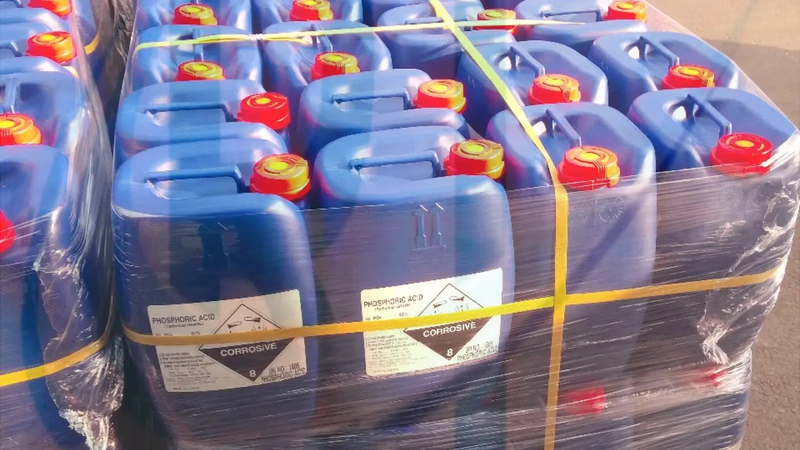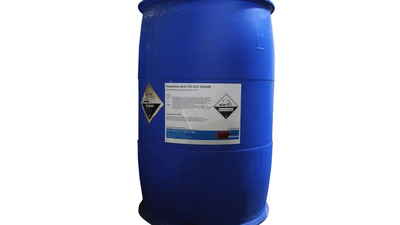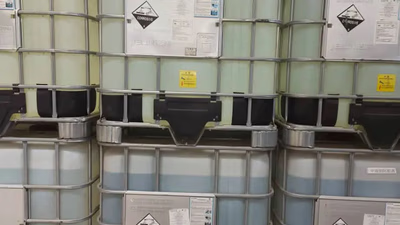
Phosphoric acid applications in agriculture and food industries.
Phosphoric acid is a strong acid with three dissociable hydrogen atoms. Its acidity makes it useful in various industries that require pH adjustment, acidification, or neutralization of alkaline substances. Phosphoric acid is employed in numerous industries to control and regulate pH levels. It can be used to both increase and decrease acidity, depending on the specific application requirements. Its ability to adjust pH makes it valuable in industries such as food and beverage, water treatment, and chemical manufacturing.
In the food and beverage industry, phosphoric acid acts as an acidulant and flavor enhancer. It provides a tangy, acidic taste that enhances the flavor profile of various products. It is commonly used in carbonated soft drinks, jams, jellies, and processed meats. Phosphoric acid contains phosphorus, an essential nutrient for plant growth. It is widely used in the production of phosphate-based fertilizers, which help replenish soil phosphorus levels and promote healthy plant growth and development. Phosphoric acid serves as a vital component in the agricultural industry, supporting global food production.
Oral phosphoric acid is an important ingredient in the production of foodstuffs which is widely used as a flavoring in production of carbonated beverages. This substance is very important in the food industry due to its availability and cheaper price than other flavorings. This substance doesn't cause major harmful to the body and is said to be of great importance for the body metabolism due to its phosphorus element.
Phosphorus is one of the vital elements needed by plants that is present in almost all plant processes. This element provides the energy needed to carry out the reactions that take place in the cells, so soils that are enriched with phosphorus cause plants to grow better. Phosphoric acid is a good choice for agricultural fertilizers due to its phosphorus element. Phosphorus is one of the vital elements needed by plants that is present in almost all plant processes. This element provides the energy needed to carry out the reactions that take place in the cells, so soils that are enriched with phosphorus cause plants to grow better. Phosphoric acid is a good choice for agricultural fertilizers due to its phosphorus element.
Water is always present in the washing process with a detergents alongside, the presence of various decrepitate such as gypsum, lime, organic compounds, etc. in the water causes hardness in it and after combining with variety of detergents They form insoluble sediments and eventually cause stains on clothes during washing. Due to the different amount of these impurities in the components of detergents, phosphoric acid is used to soften the water, which prevents the formation of sediments and no longer see unusual stains on clothes. If steel tools are oxidized, phosphoric acid can be used to remove iron rusting and iron can be used in water-soluble phosphates. After solving this problem, the iron phosphate produced is converted to black iron compound, which itself can be a factor to prevent corrosion.
Phosphoric acid is utilized as a reactant or catalyst in various chemical reactions and synthesis processes. It is involved in the production of phosphate salts, which find applications in water treatment, metal surface treatment, and detergent manufacturing. Phosphoric acid derivatives are also used in the synthesis of pharmaceuticals, flame retardants, and other specialty chemicals. The corrosive nature of phosphoric acid makes it effective for cleaning and etching applications. It is commonly used to remove rust and oxide layers from metal surfaces, acting as a rust converter and surface cleaner. Phosphoric acid is also employed in metal etching processes to prepare surfaces for painting, coating, or bonding.
Phosphoric acid is utilized in water treatment processes to control alkalinity, adjust pH levels, and prevent scale formation. It is commonly employed in cooling towers, boilers, and water treatment plants to maintain water quality, prevent corrosion, and ensure efficient operation. Phosphoric acid is used in the pharmaceutical industry for various purposes, including the formulation of medications, as a pH regulator in drug preparations, and as an excipient in tablet coatings. It also plays a role in medical diagnostic tests and procedures.
-

Phosphoric acid, or orthophosphoric acid, is a mineral acid with the formula H₃PO₄. It is produced through either the wet or thermal process. The wet process involves reacting phosphate rock with sulfuric acid, resulting in a mixture that is filtered and purified to yield phosphoric acid. This triprotic acid has a pH of around 2. 2, indicating its strong acidity. Phosphoric acid is widely used in various industries, particularly in food and beverages as a flavor enhancer and preservative. It plays a crucial role in the production of phosphate-based fertilizers like DAP and MAP, essential for plant growth. Additionally, it is utilized in metal surface treatment and the synthesis of pharmaceuticals and detergents.
While generally safe when handled properly, concentrated phosphoric acid can cause burns and eye damage; thus, protective equipment is necessary during handling. Its applications extend across agriculture, food processing, cosmetics, and industrial processes.
-

Phosphoric acid is a versatile compound utilized across various industries due to its ability to adjust pH levels. In the food and beverage sector, it serves as an acidulant and flavor enhancer, commonly found in carbonated drinks and processed foods. Its role in agriculture is significant, as it is a key ingredient in phosphate-based fertilizers that promote plant growth by replenishing soil phosphorus. Additionally, phosphoric acid aids in water treatment by controlling alkalinity and preventing scale formation in cooling towers and boilers. It also finds applications in chemical manufacturing, where it acts as a reactant or catalyst for producing phosphate salts used in detergents and pharmaceuticals. The cleaning properties of phosphoric acid make it effective for rust removal and metal surface preparation. Overall, its diverse applications highlight its importance in enhancing product quality and supporting various industrial processes.
-

West Asia, particularly Saudi Arabia, Jordan, and Morocco, is a significant player in the phosphoric acid market due to its abundant phosphate rock reserves. These countries are major producers and exporters of phosphate-based fertilizers, which utilize phosphoric acid as a key ingredient. The region"s strategic location and access to resources have fostered growth in the phosphoric acid sector. Beyond fertilizers, phosphoric acid is utilized in various industries such as chemicals, food and beverages, and metal treatment. The increasing industrialization in West Asia has heightened demand for this versatile compound. Despite being a major exporter, the Middle East also imports phosphoric acid to meet local needs due to lower production levels. Investments in new production facilities are underway but will not be operational until after 2025. For instance, the National Iranian Copper Industrial Company plans to invest 250 million euros into developing phosphoric acid plants that will require substantial phosphate soil imports annually.
The market is expected to grow driven by population increases and rising food demands while facing challenges from price fluctuations and environmental regulations. Overall, the region"s investments in infrastructure and production capabilities position it competitively within the global phosphoric acid market.
-

Phosphoric acid production primarily utilizes the wet process, where phosphate rock is mined, ground, and reacted with sulfuric acid to yield phosphoric acid and calcium sulfate. This method is favored for its lower energy requirements and higher purity of the final product. The wet process involves filtering the mixture to separate solid calcium sulfate from liquid phosphoric acid, which is then concentrated through evaporation. An alternative method, the thermal process, involves burning elemental phosphorus to produce phosphorus pentoxide, which is then dissolved in water to form phosphoric acid. While both methods have their pros and cons, the wet process remains dominant due to its efficiency. Environmental sustainability is becoming a key focus in production practices, with efforts aimed at reducing waste and minimizing ecological impacts. Historical context reveals that phosphoric acid has been recognized for its agricultural benefits since the 19th century, leading to its widespread use as a fertilizer. As industries evolve, sourcing reliable phosphate mineral ores has become essential due to past challenges with bone prices.
-

Phosphoric acid, derived from phosphorus, has a rich history dating back to the late 17th century when Hennig Brand first isolated phosphorus. The understanding of phosphoric acid evolved significantly in the early 19th century through the work of chemists like Jöns Jacob Berzelius. Initially produced via the bone-ash process, which treated bones with sulfuric acid, commercial production began in the mid-19th century. The wet process emerged in the early 20th century, replacing the bone-ash method due to its efficiency. The molecular structure of phosphoric acid (H₃PO₄) was elucidated in the late 19th century, leading to its widespread use in agriculture as a fertilizer and in various industries such as detergents and food production. Phosphoric acid became essential for enhancing crop yields and was later recognized for its role as an acidulant in beverages. Regulatory bodies have since established safety standards for its use in food products. However, environmental concerns regarding phosphate mining and processing have prompted efforts to improve sustainability within the industry.





